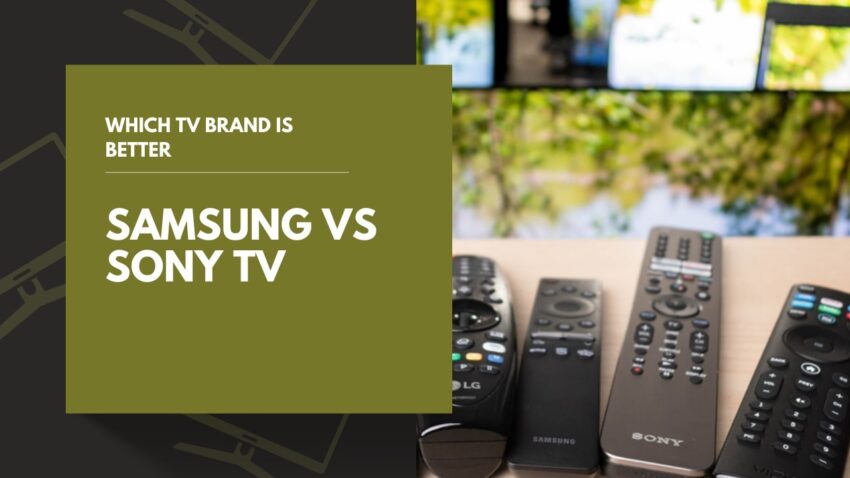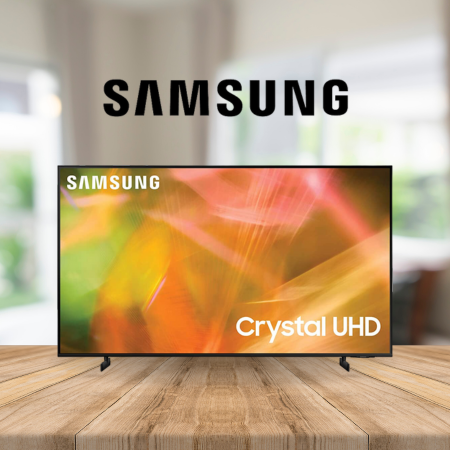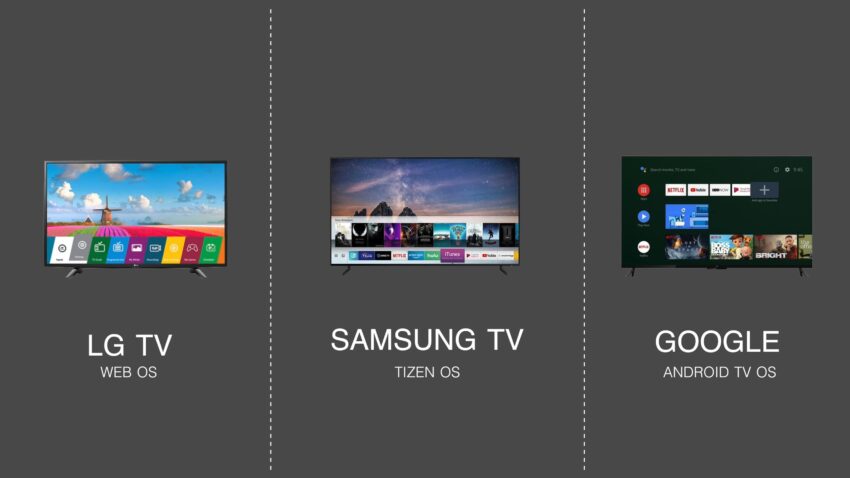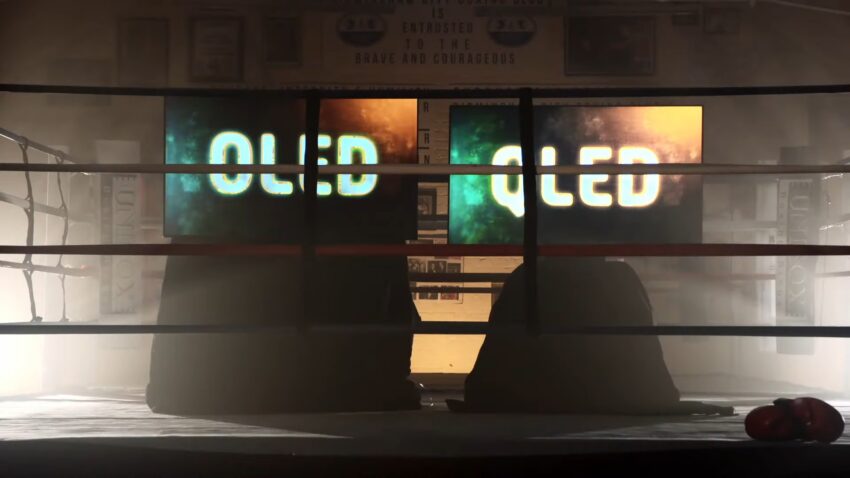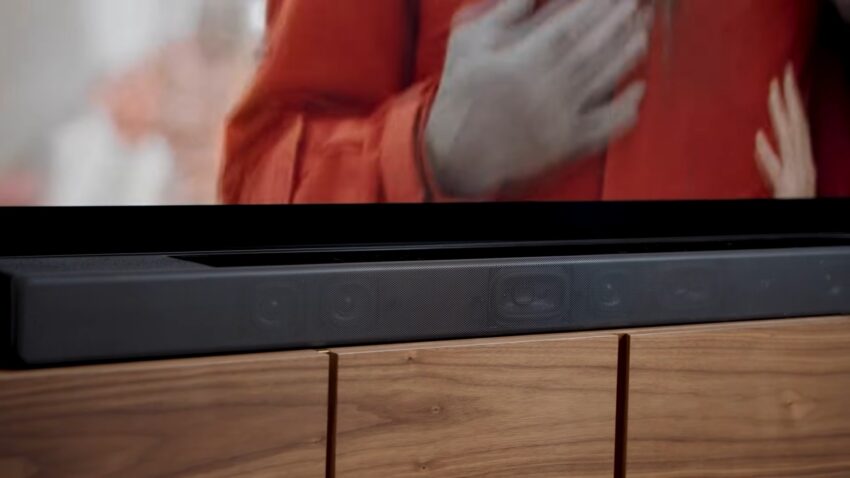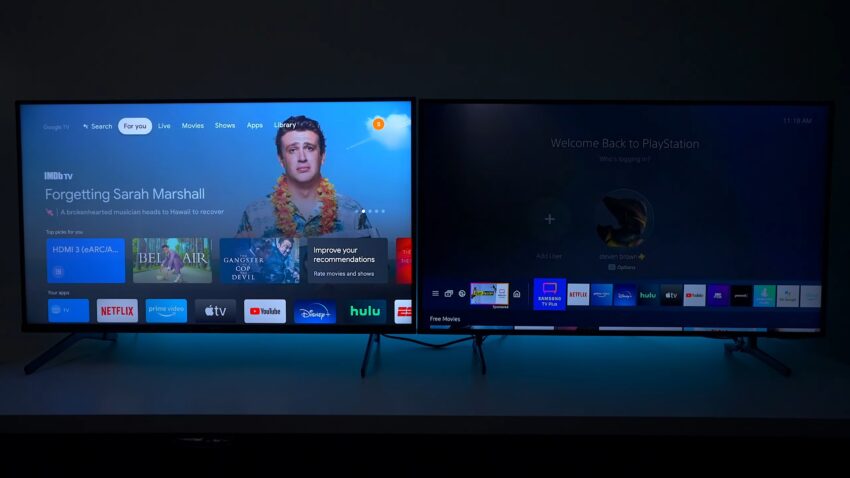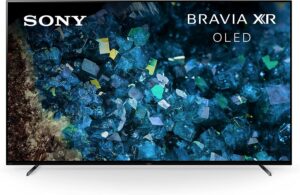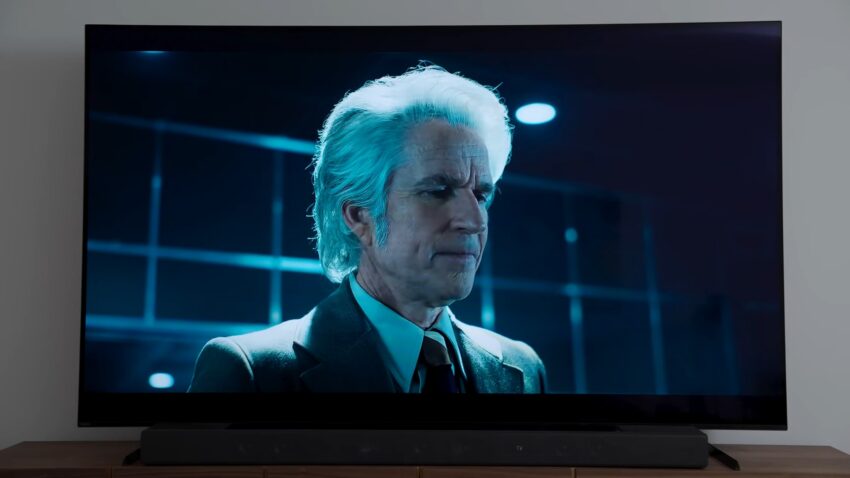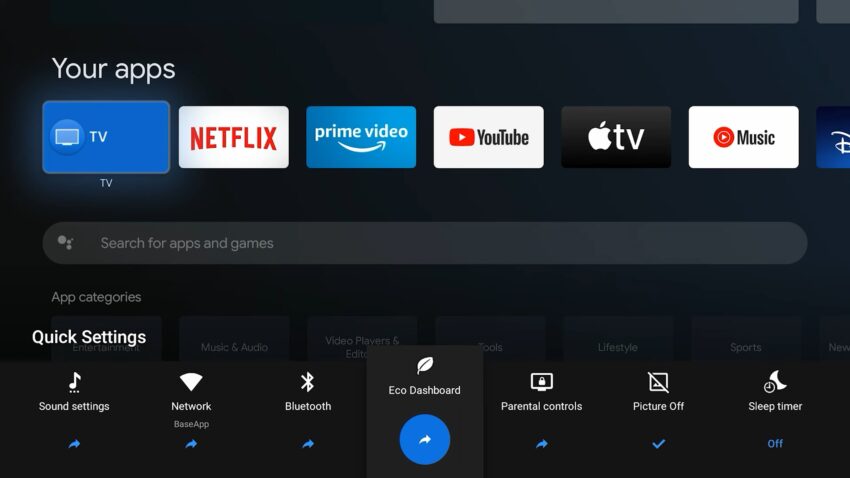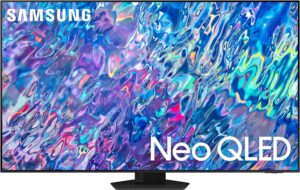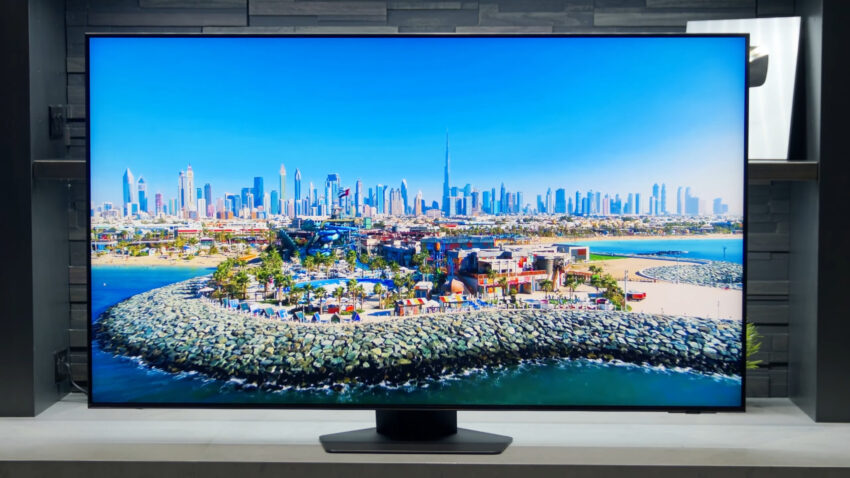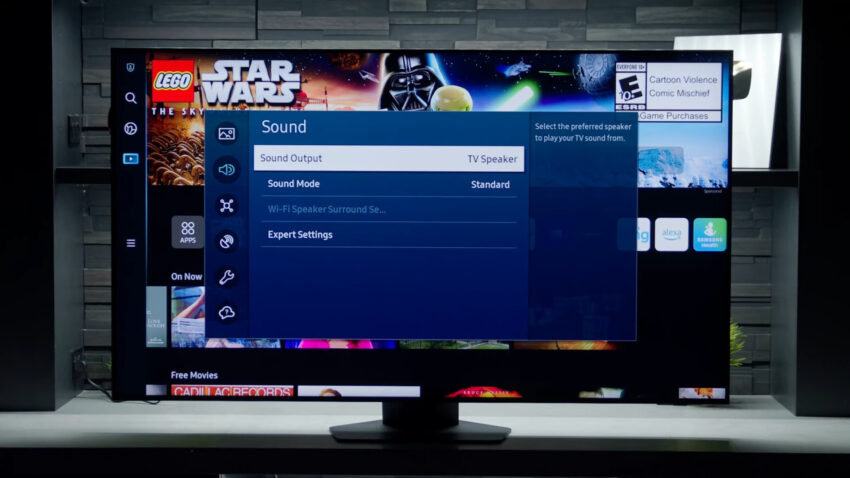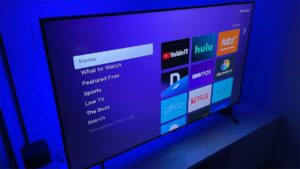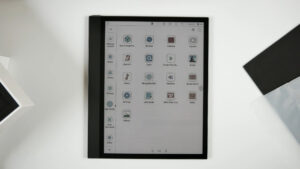If you’re in the market for a new TV, you’ve probably found yourself stuck between two giants in the industry: Samsung and Sony. Both brands are renowned for their high-quality displays, innovative features, and commitment to enhancing your viewing experience. But when it comes down to it, which one is truly the better choice?








In this guide, I’m going to talk about the Samsung vs Sony TV debate. We’ll explore the strengths and weaknesses of each brand, compare their latest models, and discuss the key factors you should consider when choosing between them. This isn’t about declaring a clear winner but rather about helping you decide which brand aligns best with your specific needs and preferences.
So, whether you’re a movie buff looking for the best cinematic experience, a gamer seeking the lowest input lag, or a sports fan wanting the smoothest motion, this guide is for you. Let’s get started and see what Samsung and Sony have to offer in 2024!
An Overview
Let’s just set the scene. First, Samsung is a manufacturer in South Korea, and by far the world’s largest television producer, followed by LG and TCL.
However, Sony is not far behind – and the Japanese manufacturer is still a competing force.
Sony and Samsung produce budgets of all sizes, from 40-inch small TVs to large 65-inch screens, with an annual product cycle upgrading most of these sets every year. The majority are best 4K TVs, but with either brand, you will find the strangely cheap HD display.
Both brands also produce a number of consumer products outside televisions. Without Sony, you wouldn’t have a PlayStation 4 and the upcoming PS5 is going to be the company’s major product launch. Also, be assured that Sony makes televisions capable of showing off what its next-gen console can do – and both TV makers do have an 8K-resolution branded TV.
Even in the highly competitive smartphone industry, Sony and Samsung are battling for territory: they both produce Android phones, although we will not compare their handsets in this specific guide.
Smart TV: Tizen vs Android TV
With each television make there appears to be a specific smart TV platform, each with its own unique style.
Samsung aims for the mid-range and luxury televisions with its Tizen OS. Tizen is easy to navigate and typically uncluttered – with a continuously refreshing ‘latest’ box that helps you to keep track of your most commonly used apps. Overall, a pretty competent experience, but not as accomplished as the webOS framework of LG’s universal search feature.
On the other side, Sony uses Android TV, which provides a little more functionality and menu boards than their competitor. It’s a little more cluttered but more at your control as well. Although Android TV is also considered to be somewhat buggier and prone to crashes than other smart TV platforms, it’s really up to your choice.
But what of voice assistants? Advanced Sony TVs will come with Google Assistant integration – which makes sense, given Android TV is a Google-developed platform.
However, Sony has now added an Amazon Alexa Music, Cameras and TV Control feature to its best 4k TVs, as well as some previous-year mid-range versions. This will allow you to control smart home devices and speakers from third parties via some basic Alexa features – such as the Amazon Echo or security cameras from Ring – and use Alexa’s voice commands for the power and volume functions of the TV.
Samsung’s Bixby voice assistant can be found on mid-range sets and beyond, but in terms of smarts or voice recognition, it is considered to lag behind Alexa or Google Assistant. But for the limited TV controls, you are likely to use Bixby for, it’s more than enough – and you can still connect your TV with an Alexa speaker if you really want to.
QLED or OLED?
Today’s premium television market is divided into two-panel technologies: OLED and QLED (basically an LED-LCD screen with quantum dots).
The best all-around TV that money can buy. That is the answer to what is an OLED TV. They offer the most high-end result while maintaining a relative cost to their performance, unlike QLED TV. In this case then, if you find yourself with a large budget and want a TV that will outperform all other TVs, then an OLED TV will be the best for you
On the other side, QLED is a unique technology that Samsung develops. QLED utilizes a quantum dot filter to improve color and contrast, which utilizes a variety of dimming zones to adjust brightness throughout the panel – rather than being able to do so individually for each pixel. QLED TVs are often much clearer than OLEDs, but they can struggle to continuously display both light and dark images.
Dolby Vision vs HDR 10+
If you buy a mid-range television up to one of the top-of-the-line sets, it will definitely come with high-dynamic-range (HDR) support, but you might not know that HDR comes in various types.
Any HDR TVs support a base HDR10 format – which has a wider variety of colors and better contrast compared to standard SDR TV. Most of the TV content these days is still in SDR, but every year more films, series, and shows are made in HDR.
Even beyond this, there are two HDR formats this adds ‘dynamic metadata’ to improve TV pictures by adjusting the picture settings of the TV depending on the scene you are watching and the types of pictures on the screen.
The first was Dolby Vision, supported by both Sony and LG, and found amongst others in TVs across Vizio, TCL, and Hisense. Then there’s HDR10 +, sponsored by Samsung and Panasonic – although the latter has now been tilting to offer both mid-range and luxury television formats.
Dolby Vision is the most advanced format, with a 12-bit color gamut instead of the 10-bit HDR10 +, which is also used more commonly. (While Amazon Prime has a range of HDR10 + shows, you won’t find it supported on Netflix or devices such as Chromecast Ultra and Apple TV 4K.)
Samsung vs Sony TV: which should you choose?
Not sure about either of those? Both Sony and Samsung are capable mainstream TV makers, so one or the other is unlikely to get you out with a purchase. Most of our concerns about premium Sony and Samsung sets gear around format support – the quality of the picture is generally brilliant either way. And if you are dedicated to Dolby Vision or HDR10 + as an HDR format, your decision for you.
Samsung’s QLED sets are going to go big on brightness, and if you’re more of a daytime spectator than a huddle-in-the-dark cinephile, the brighter displays are maybe more of what you’re after. Otherwise, Sony’s OLEDs would give your late-night movie sessions a crisp image with incredible contrast.
It is worth noting that the QLEDs of Samsung features a new Ultra Vision Angle system, which makes vision off-axis dramatically improved. On the other hand, Sony is typically very capable of upscaling from low-resolution sources, and of handling motion in fast-moving images.
But which television brand is better? It depends on what you want from a new TV – and if price affects you more than any snazzy formats or contrast comparisons, we’ve listed some of the current prices below for Sony and Samsung TV. (You can get on a tight budget if you’re after the best TV, though, the Samsung NU7100 is probably your best bet).
| Feature | Samsung | Sony |
|---|---|---|
| Panel Technology | QLED | OLED |
| Smart TV Platform | Tizen OS | Android TV |
| Voice Assistant | Bixby | Google Assistant, Amazon Alexa |
| Native HDR Support | HDR10+ | Dolby Vision |
| Brightness | Higher brightness | Lower brightness compared to QLED |
| Viewing Angles | Improved with Ultra Viewing Angle technology | Good viewing angles |
| Upscaling | Good upscaling | Great upscaling |
| Motion Handling | Good motion handling | Excellent motion handling |
Sound Quality
While picture quality tends to steal the spotlight, sound quality is equally important for a fully immersive viewing experience. Let’s take a closer look at how Samsung and Sony stack up in this department.
Samsung: Object Tracking Sound
Samsung has invested heavily in sound technology to create a more enveloping auditory experience. Their Object Tracking Sound (OTS) technology, for example, utilizes multiple speakers placed around the TV to produce three-dimensional sound. This makes it feel as if the audio is coming from the exact spot where the action is happening on the screen, enhancing the sense of immersion.
Another notable feature is the Q-Symphony, available in high-end QLED models. This technology allows the TV speakers to work in tandem with a compatible Samsung soundbar, effectively broadening the sound stage and adding a layer of depth to the audio.
Sony: Acoustic Surface Audio
Sony’s approach to sound is just as innovative but fundamentally different. The brand’s Acoustic Surface Audio technology actually uses the OLED screen itself as a speaker. Vibrations from the screen produce sound, aligning the audio precisely with the action on-screen. This results in a highly synchronized auditory experience that feels natural and captivating.
Additionally, Sony TVs often come equipped with Dolby Atmos support, offering a more expansive sound field. This feature, often found in higher-end models, delivers a cinematic audio experience that can make you feel like you’re in the middle of the action.
Durability and Reliability
When you’re investing in a high-end TV, you want it to last. Durability and reliability are key factors to consider before making a purchase. Both Samsung and Sony are known for their quality manufacturing and long-lasting products, but there are subtle differences.
Samsung: Built to Last
Samsung is known for robust build quality, particularly in its higher-end QLED models, which often come with a metal frame and solid construction. Furthermore, Samsung offers a comprehensive warranty and has a wide network of service centers, making it easier for customers to get assistance if problems arise.
- One Connect Box: Certain high-end models offer the One Connect Box, which houses all the HDMI and power ports, reducing cable clutter and making it easier to set up and move the TV.
- Burn-In Free: Unlike OLED panels, QLED TVs are virtually immune to burn-in, making them more durable for long-term use.
Sony: Quality Meets Design
Sony puts a strong emphasis on build quality as well as aesthetic design. The brand is known for its sleek, minimalist designs that blend seamlessly into any living environment. Sony TVs generally offer excellent build quality, with materials that are both durable and premium to the touch.
- CalMAN Ready: Some of Sony’s higher-end models are CalMAN Ready, meaning they are optimized for professional calibration, ensuring that your TV performs at its best for years to come.
- Longevity: Sony’s OLED panels are engineered for durability, featuring various technologies to minimize the risk of burn-in and prolong the lifespan of the TV.
Customer Support and Warranty
Last but not least, customer support and warranty services are pivotal factors that can greatly influence your TV buying experience. Both Samsung and Sony offer extensive customer service networks, but how do they stack up against each other?
Samsung: Extensive Network
Samsung has a broad network of customer service centers and offers various methods for support, including phone, email, and live chat. Their warranty periods are competitive, generally ranging from 1 to 2 years depending on the model and region.
- Self-Diagnostic Tools: Some Samsung TVs come equipped with self-diagnostic tools that can troubleshoot minor issues, making it easier for you to resolve problems without professional assistance.
- Online Support: Samsung’s website offers extensive resources, including FAQs, guides, and video tutorials, providing customers with multiple avenues for self-help.
Sony: Quality Service
Sony’s customer service is also highly rated, offering multiple channels for support. They offer a standard 1-year warranty for their TVs, but extended warranties can be purchased for added peace of mind.
- Eco-Friendly: Sony is committed to reducing its carbon footprint, offering a recycling program that helps customers dispose of their old TVs responsibly.
- Premium Support: For high-end models, Sony offers premium support services, including expert installation and personalized customer service, ensuring a seamless experience from purchase to setup.
Our Sony TV Recommendation
Sony OLED 65-inch BRAVIA XR A80L Series 4K Ultra HD TV
I recently had the opportunity to test out Sony’s latest 65-inch OLED 4K TV, and I must say, it left me thoroughly impressed.
The brand is known for its attention to detail and high-quality visuals, but this particular model takes it a notch higher. Let me break down my experience for you:
Picture Quality
The Cognitive Processor XR is a game-changer. The contrast and color reproduction are top-notch, thanks to the XR OLED Contrast Pro and XR Triluminos Pro technologies.
Blacks are deep and detailed, which makes watching movies and playing games an incredibly immersive experience. The 4K resolution and 120Hz refresh rate make everything look smooth and sharp.
Smart Features
Navigating through the wide array of supported Internet services like Netflix, Disney Plus, Prime Video, Hulu, and more is a breeze, all thanks to Google TV.
The Google Assistant feature allows you to voice search and ask questions seamlessly. The support for Apple AirPlay is a nice addition for iPhone users.
Sound Quality
The Acoustic Surface Audio+ provides an enveloping sound experience. The audio matches the video in terms of quality and adds a whole new dimension to your viewing experience.
Gaming
As a gamer, I was thrilled with the gaming menu that consolidates all the settings I would need into one interface. It even has exclusive features for the PlayStation 5, like Auto HDR Tone Mapping and Auto Genre Picture Mode.
The HDMI 2.1 support ensures high-performance gaming with features like 4K/120, VRR, and ALLM.
Special Features
The NEW Eco Dashboard is a unique addition that lets you monitor energy consumption, aligning with the modern trend of environmental consciousness.
Another special offering is the BRAVIA CORE app, which gives you 5 credits to redeem on the latest release movies and a 12-month subscription on hundreds of classics.
Connectivity
Connectivity options are plenty, including Bluetooth, Wi-Fi, USB, Ethernet, and HDMI. Setting up the TV was quite simple, with all the necessary components like the power cable, remote control, AAA batteries, and stand included in the package.
Verdict
This Sony 65-inch OLED 4K TV is a complete package that excels in almost every department. Whether you’re a cinephile, a binge-watcher, or a gamer, this TV has something to offer you.
The exclusive features for the PlayStation 5 make it a dream come true for gamers. All in all, it’s a premium investment that you won’t regret.
- Exceptional OLED display
- Rich, immersive audio
- Smart TV features
- Ultra-slim design
- Energy-efficient operation
- Gaming-friendly
- Premium price tag
- Limited HDMI ports
Our Samsung TV Recommendation
SAMSUNG 65-Inch Class Neo QLED 4K QN85B Series
Right out of the box, the Samsung QN65QN85BAFXZA 65-inch 4K QLED TV makes a statement. With its sleek design and 11.2″D x 56.9″W x 35.1″H dimensions, it immediately captures attention without overpowering the room.
Setting it up was quite straightforward, thanks to the included user manual and other components like the SolarCell Remote™ TM-2280E and power cable.
Display and Picture Quality
The QLED display technology is nothing short of phenomenal. It promises 100% color volume with Quantum Dot technology and delivers spectacularly. The 4K resolution and 120 Hz refresh rate make sure the images are crisp, vibrant, and fluid.
Moreover, the Quantum Matrix Technology and mini LEDs ensure that the bright areas are super bright, and the darks are as deep as they should be. HDR10+ makes an additional contribution to the TV’s stunning visuals, offering dynamic contrast and vivid colors.
Special Features
What sets this TV apart are its special features like Real Depth Enhancer and Motion Xcelerator Turbo+.
Watching nature documentaries felt like a completely immersive experience thanks to the Real Depth Enhancer. It genuinely reproduces depth in a way that mirrors how the human eye processes it, providing an uncanny realism.
The Motion Xcelerator Turbo+ is a game-changer for action movies, sports, and video games. Even in high-speed scenes, the lag is almost non-existent, and motion blur is significantly reduced.
Sound Experience
Samsung has also hit a home run with Dolby Atmos and Object Tracking Sound. The sound is as captivating as the display, moving in sync with the action on screen.
Whether it’s the rustle of leaves or an explosion, the auditory experience is as realistic as it gets.
Smart Features
I love the range of supported Internet services, from Netflix and Prime Video to more niche options like Nvidia GeForce NOW. The TV’s Neo Quantum Processor with 4K upscaling ensures everything looks its best.
Smart Calibration is another useful feature that lets you optimize your display settings easily via your smartphone, and it works in as little as 7 to 12 minutes. And let’s not forget the voice assistants; whether you’re in the Alexa, Google Assistant, or Bixby camp, this TV has got you covered.
Verdict
Samsung’s QN65QN85BAFXZA provides an exceptional viewing and listening experience, packing a plethora of features into a beautiful, well-designed package. It’s not just a TV; it’s an entertainment hub that promises and delivers much more.
- 4K QLED with vibrant colors
- Object Tracking Sound+
- Quantum Processor 4K
- Adaptive Picture & Sound
- Built-in voice assistants
- Pricey
FAQ
Which brand has better customer support?
Both Samsung and Sony have extensive customer support networks, and their quality may vary depending on your location. It’s best to check customer reviews for your specific region to determine which brand has better customer support in your area.
Are Samsung and Sony TVs energy efficient?
Both Samsung and Sony TVs are generally energy efficient, with most models featuring energy-saving settings and options. The actual energy consumption may vary depending on the model and usage patterns.
How long do these TVs usually last?
The lifespan of a TV depends on its usage and care. On average, Samsung and Sony TVs can last anywhere from 7 to 10 years or more with proper care and maintenance.
What is the difference between QLED and OLED in terms of image quality?
QLED TVs generally offer higher brightness levels and vibrant colors, making them suitable for well-lit rooms. OLED TVs, on the other hand, provide better contrast and deeper blacks, making them ideal for dark room viewing and movie enthusiasts.
How often do Samsung and Sony release new TV models?
Samsung and Sony typically release new TV models on an annual basis, with updated features and improvements. However, it’s not necessary to upgrade your TV every year, as most TVs are designed to last for several years with proper care and maintenance.
Can I connect them to my home theater system?
Yes, both Samsung and Sony TVs come equipped with various connectivity options, such as HDMI and optical audio outputs, which can be used to connect them to home theater systems for an enhanced audio experience.
Can Samsung and Sony TVs be wall-mounted?
Yes, both Samsung and Sony TVs are generally compatible with VESA mounts, making it easy to wall-mount them.
However, the specific mount you’ll need depends on the size and weight of the television. Always check the manufacturer’s guidelines for recommendations on wall-mounting.
What types of gaming features can I expect from Samsung and Sony TVs?
Both brands have TVs that cater to gamers, offering features like low input lag, high refresh rates, and compatibility with various gaming consoles.
Sony TVs often integrate well with PlayStation consoles, providing an optimized gaming experience. Samsung, meanwhile, has a dedicated “Game Mode” in many models that optimize settings for quicker response times.
Do Samsung and Sony offer any accessibility features on their TVs?
Yes, both brands offer a range of accessibility features including voice narration, magnification, and customized subtitle options to make their TVs more accessible to users with disabilities. The availability and extent of these features may vary depending on the model.
Is it possible to install third-party apps on Samsung and Sony Smart TVs?
Sony, running on Android TV, generally allows for a broader range of third-party apps to be installed via the Google Play Store.
Samsung’s Tizen OS is more restricted, but it still offers a wide array of popular streaming and utility apps from its own store.
Do these TVs support AirPlay or Chromecast for screen mirroring?
Sony TVs with Android TV usually have built-in Chromecast functionality, which allows for easy screen mirroring from compatible devices.
Samsung TVs don’t natively support Chromecast but do have their own screen mirroring technology. Some Samsung models also support AirPlay 2 for Apple devices.
Can I control my Samsung or Sony TV using my smartphone?
Yes, both Samsung and Sony offer companion apps for smartphones that allow you to control the TV.
These apps can turn your phone into a remote control, allow you to browse and launch apps, and even share content between your TV and smartphone.
Final Words
After the discussion of the Sony vs. Samsung TV debate, I’ve realized it really comes down to personal taste and needs. If you crave bright displays and a simple interface, Samsung’s QLED and Tizen OS are for you. They shine in well-lit rooms.
But if you’re a movie buff who loves deep blacks and contrast, Sony’s OLED TVs and their Android TV platform won’t disappoint, especially in a dark setting. Both brands are strong contenders, offering features like HDR10+ for Samsung and superb motion handling for Sony. So take stock of what matters most to you and your budget, and you can’t really go wrong with either.
Related Posts:
- LED vs LCD - Which is the Best TV - Battle of the Screens
- Samsung vs LG TV - Which TV Brand is Better to Buy in 2024?
- Sony X900H vs LG NANO90 2024 - Battle of the 4K Titans
- 8K VS 4K and Upscaling Is 8K Worth the Upgrade? -…
- 7 Best 24-28 Inch 1080p Smart TV 2024 - Small…
- Sony X900H vs X900F - Which TV Reigns Supreme?


